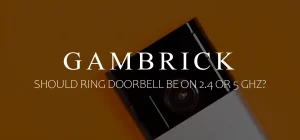
Is Ring Doorbell Secure?
Smart doorbells are the latest trend in home security. According to a study, over 20 million U.S. households had installed smart doorbells like Ring by the end of 2021. But, as these devices gain popularity, there’s an important question homeowners and renters should ask: Is a Ring doorbell actually secure?
In today’s digital age, anything connected to the internet is vulnerable to security risks. From bank accounts to baby monitors, cybersecurity is a major concern. In fact, cybercrime is projected to cost the world $10.5 trillion annually by 2025. So, when it comes to smart doorbells like Ring, which capture video footage of your home’s entrance, it’s only natural to question how secure a Ring video doorbell really is.
Here are some key stats to remember:
- A burglary occurs every 30 seconds in the U.S.
- Weak passwords are the cause of 81% of data breaches.
- Homes with visible security systems are 300% less likely to be broken into.
- Cybercrime is projected to cost the world $10.5 trillion annually by 2025.
These statistics highlight the necessity of proactive home security measures, and Ring Doorbell can be a robust component in that safety toolkit.
By following best practices like using strong passwords, regularly updating software, and limiting shared access, a Ring video doorbell can be a secure part of a comprehensive home security system.
This article will discuss the security features of a Ring Doorbell. We’ll explore its physical security measures designed to deter thieves and vandals, as well as its digital security features that protect your data and privacy.

Ring Doorbell Physical Security Features
We’ve all heard stories or maybe even witnessed instances where traditional doorbells get stolen or vandalized. That could make anyone skeptical about installing a fancy new Ring video doorbell. But Ring has some built-in physical features to help deter thieves and keep your device safely attached to your home.
1. Tamper-Resistant Design
Ring Doorbells come with a tamper-resistant design. This means the device has a special feature that notifies you if someone tries to mess with it.
With 1 in 5 Americans falling victim to package theft, having a doorbell that can’t be easily tampered with is crucial.
Let’s say someone tries to pry off your Ring Doorbell. The device’s built-in sensors will detect this and immediately send an alert to your phone, giving you the opportunity to check the live feed or notify the authorities.
Ring Doorbells are installed to be secure and tamper resistant. However, eventually you may move or want to change the Ring, in which case, you’ll need to remove it. Here’s an article explaining how to remove a Ring Doorbell should you ever have to.
2. Secure Installation Options
Ring Doorbells offer various secure installation options, including lockable mounts and proprietary screws that are difficult to remove without specialized tools.
According to the FBI, a burglary occurs every 30 seconds in the U.S., so it’s crucial to have a doorbell that’s securely attached to your home.
Many Ring Doorbell models come with a specific type of screw head that’s not commonly found in typical toolsets. This makes it harder for someone to just walk up and unscrew your doorbell.
Ring often includes security stickers that you can place around your property. These act as a visual deterrent, and studies have shown that homes with visible security systems are 300% less likely to be broken into.
The best video doorbell models do not use WiFi, which makes them less likely to be hacked. Instead, they’re hard wired using an Ethernet cable for internet access and power.
By understanding and utilizing these physical security features, you’re adding an extra layer of protection to your home. In the next section, we’ll delve into the digital safeguards that Ring Doorbell offers.
Some Ring models can be installed with the power on, while other require the power to be turned off. The difference lies in how the Ring is powered. To find out if you can install your Ring Doorbell with the power on or off, click the link.
Ring Doorbell Digital Security Features
So, your Ring Doorbell is physically secure, but what about the digital side of things? After all, cyberattacks are on the rise, with experts predicting that a new cyberattack will occur every 11 seconds in 2021. Let’s dig into how Ring safeguards your digital world.
1. End-to-End Encryption
End-to-end encryption means that only you and the people you choose can view your videos. Even Ring can’t peek at your footage.
It’s like having a secret code for your digital data. According to cybersecurity firm Norton, end-to-end encryption is one of the most secure ways to protect digital information.
Imagine sending a sealed letter through the mail. Only the person with the key (in this case, a digital “key”) can open it. Similarly, end-to-end encryption ensures only you and authorized users can view your Ring videos.
2. Two-Factor Authentication (2FA)
Two-Factor Authentication (2FA) requires not just a password, but a second form of identification, usually a code sent to your phone, to access your Ring account.
According to Microsoft, using 2FA can prevent 99.9% of account hacks. It’s like having a double lock on your front door.
Think of 2FA as a two-step dance. First, you enter your password (step one), and then you receive a text with a verification code (step two). You need both steps to log in, making it doubly difficult for hackers to gain access.
3. Regular Software Updates
Ring frequently releases software updates that improve security features and fix any known vulnerabilities. Around 70% of cyber attacks exploit outdated software. Staying updated is staying protected.
It’s like getting a flu shot every year. The “strains” of cyber threats evolve, and keeping your software updated ensures you’re protected against the latest risks.
Digital security is as crucial as physical security when it comes to your Ring Doorbell. By enabling features like end-to-end encryption and two-factor authentication, and keeping your software updated, you’re setting up a digital fortress around your home. Stay tuned for our next section on Data Security and Privacy for more ways to keep safe.

Ring Doorbell Data Security and Privacy
You’ve got the physical and digital bases covered, but what about your data? In a world where data breaches exposed 4.1 billion records in just the first six months of 2019, how does Ring Doorbell protect your personal information?
1. Data Storage and Cloud Services
When your Ring Doorbell captures video, that data is stored in the cloud, but not just any cloud, a secure one with multiple layers of encryption. Your video footage contains valuable information that you wouldn’t want falling into the wrong hands. In 2020, 63% of data breaches involved sensitive data like home footage.
Think of cloud storage as a high-security vault for your digital videos. Just like a bank vault has multiple layers of security, Ring’s cloud storage safeguards your video data.
2. Privacy Zones
Ring’s Privacy Zones allow you to block out specific areas that you don’t want recorded, like your neighbor’s house or window. Privacy Zones not only protect your privacy but also the privacy of others, something that 79% of Americans are increasingly concerned about, according to Pew Research.
Imagine you live close to a school and you don’t want to capture footage of children walking by. You can set up a Privacy Zone that excludes that part of the sidewalk from your Ring’s field of view.
3. Controlled Sharing
Ring lets you decide who has access to your videos. You can easily share access with family members without compromising on security. In the U.S., around 41% of households are multi-generational. Shared access ensures everyone in the home can monitor security without compromising data safety.
Picture a digital “trust circle.” You’re at the center, and you can choose to add family members to this circle, giving them permission to view videos but not alter key settings.
Data security and privacy are integral parts of your Ring Doorbell’s overall security landscape. From a secure cloud vault for your video data to privacy zones and controlled sharing, Ring has developed features that respect both your security and your privacy.
How To Maximize Ring Doorbell Security
By now, you know that Ring Doorbell comes packed with a range of physical, digital, and data security features. But like any technology, its effectiveness lies in how well you use it. Studies show that merely owning a security device is not enough; proper setup and maintenance can make a significant difference.
So what are the best practices to make your Ring Doorbell an impenetrable fortress?
1. Strong Passwords
Using a unique and strong password for your Ring account. Weak passwords are the cause of 81% of data breaches. A strong password acts like a digital guard at the gate of your account.
Don’t use easily guessable passwords like ‘password123’ or ‘yourname2023’. Instead, opt for a complex combination of upper and lower case letters, numbers, and symbols.
2. Regular Software Updates
Keeping your Ring Doorbell’s software up-to-date. As mentioned before, around 70% of cyberattacks exploit outdated software.
You wouldn’t drive a car with outdated brakes, would you? Similarly, don’t ignore those software update prompts—they’re for your security.
3. Monitor Activity Alerts
Regularly check the activity alerts on your Ring app. Being proactive can help you respond to potential security risks more quickly. In fact, a study shows that 83% of homeowners were able to prevent a break-in by acting on an alert from their security system.
If your Ring Doorbell sends an activity alert late at night and you aren’t expecting anyone, you can instantly check the live feed or call for help.
4. Limit Shared Access
Be selective when sharing access to your Ring account. The fewer people who have access to your account, the lower the risk of accidental data exposure or misuse.
Only share Ring Doorbell access with people you trust implicitly, like immediate family members, to maintain optimal security and privacy.
Your Ring Doorbell is designed to offer top-notch security, but it’s crucial that you follow these best practices to maximize its potential. This will help you stay ahead of the curve in protecting both your home and your data.
Conclusion: Is Ring Doorbell Secure?
In this article, we’ve taken a comprehensive look at the ins and outs of Ring Doorbell’s security features. From its tamper-resistant design to end-to-end encryption and privacy settings, this popular smart doorbell is engineered to provide multiple layers of security.
Here are some key stats to remember:
- A burglary occurs every 30 seconds in the U.S.
- Weak passwords are the cause of 81% of data breaches.
- Homes with visible security systems are 300% less likely to be broken into.
- Cybercrime is projected to cost the world $10.5 trillion annually by 2025.
What does this mean for you? It highlights the necessity of proactive home security measures, and Ring Doorbell can be a robust component in that safety toolkit.
By following best practices like using strong passwords, regularly updating software, and limiting shared access, a Ring video doorbell can be an integral part of a comprehensive home security system.
If you have any questions or comments about whether or not a Ring video doorbell is secure, email any time.

John Mazzuca | About | More Posts |
Custom Home Builder
John Mazzuca is a custom home designer and builder at Gambrick with over 25 years experience in the construction industry. John has designed, built and/or remodeled hundreds of homes, small buildings, and commercial projects. He writes about business, real estate, home building, and household electronics. His work has been featured in Fox Business, Better Homes & Garden, House Beautiful, and more.




















